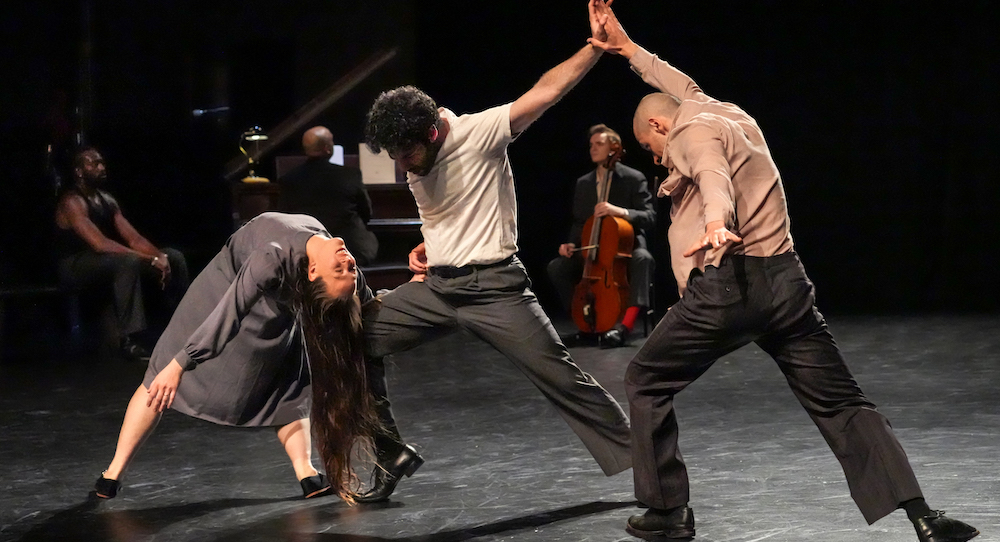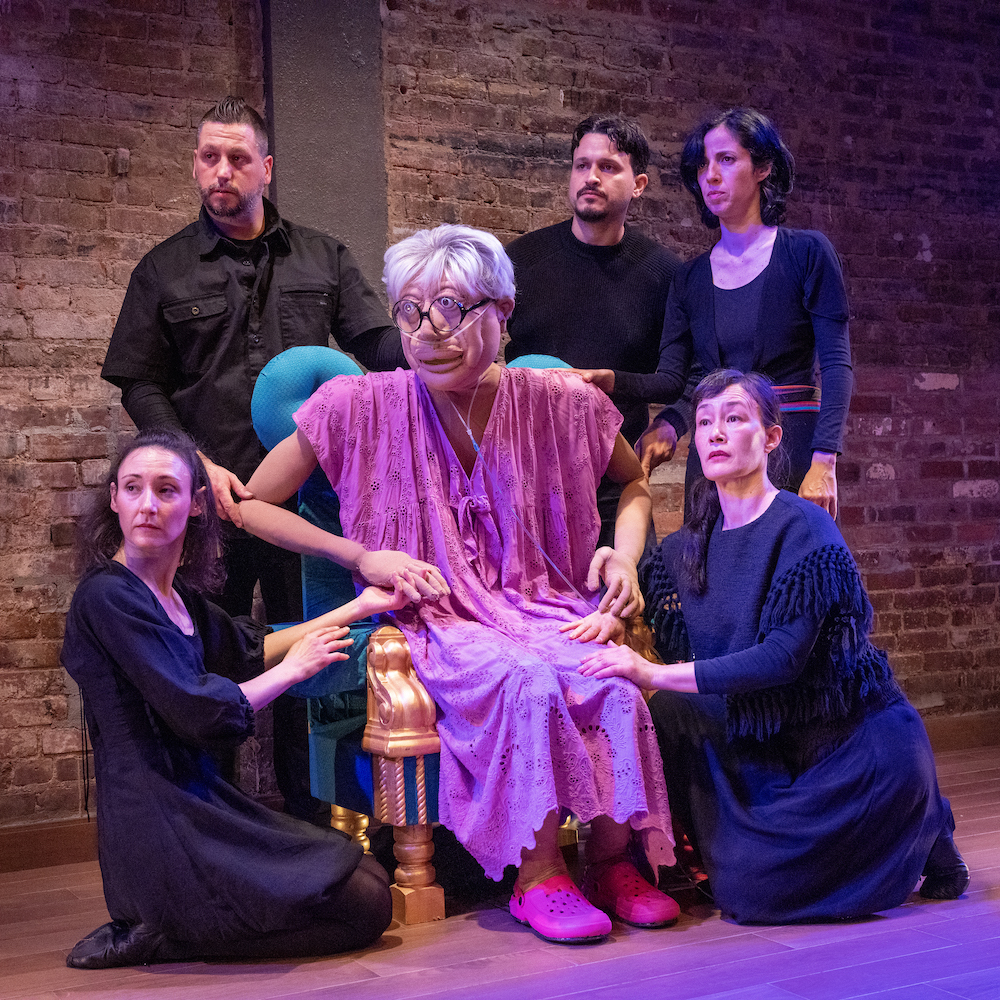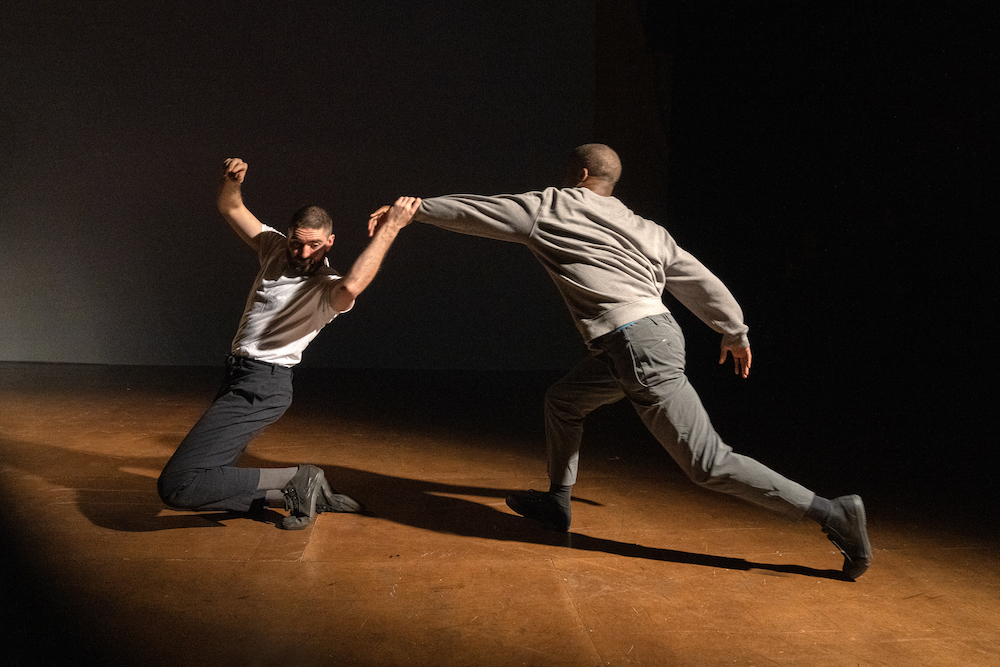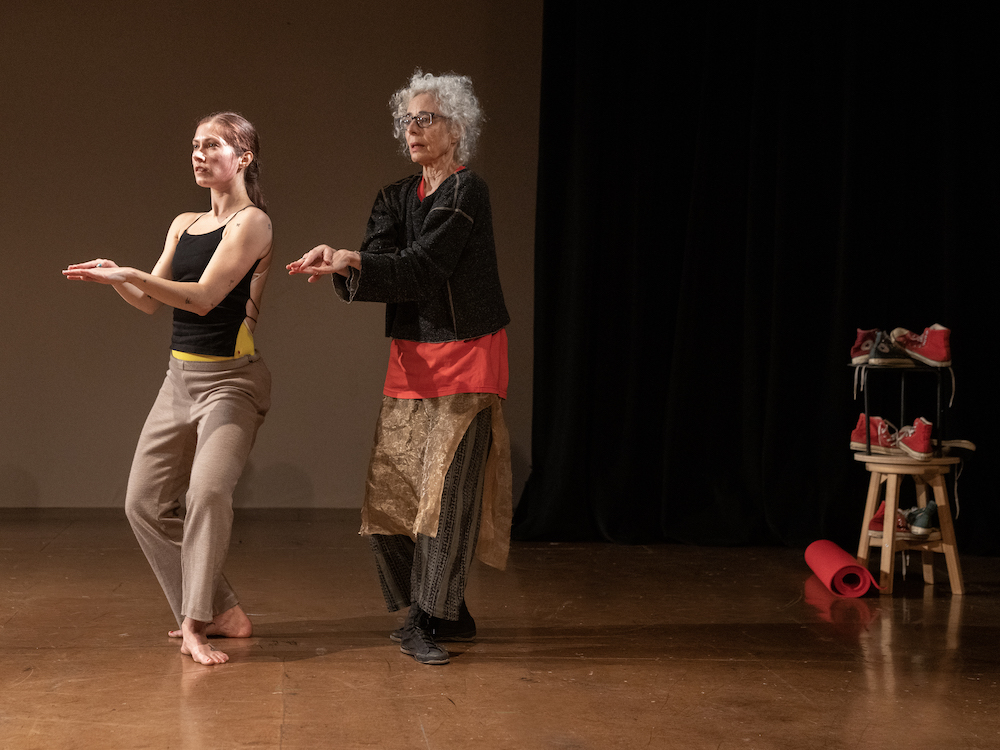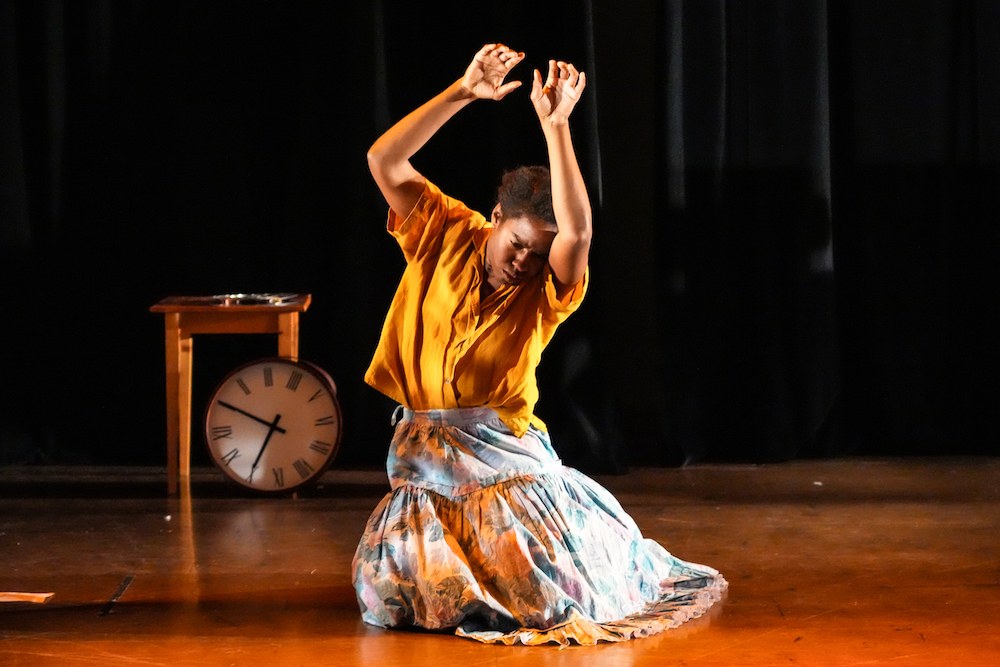La MaMa’s Ellen Stewart Theatre, The Downstairs Theatre and The Club, New York, NY.
April 6-30, 2023.
La MaMa Moves! Dance Festival, curated by Nicky Pariso, ran from April 6-30, and featured new and recent works by 12 choreographers and companies with varied approaches to performance. I had the opportunity to attend six of the shows on the program with highlights including Broken Theater by Bobbi Jene Smith, Suck it Up by Baye & Asa, and Put Away the Fire, dear, pt. 2 by Kayla Farrish.
Shadowland, a world premiere by Norwegian choreographer Kari Hoass featuring an abstract hanging sculpture by Gard Gitlestad, opened the festival. From upstage-facing torso led movement accompanied by rich cello music by Fil Uno to a slow motion collision partnered by the sounds of tectonic plates shifting, the dancers’ various entrances convey a quiet drama and have an improvisational feel. As the piece progresses, rhythms, textures and heaviness expand the movement vocabulary. Sweeping phrases are given precedence over positions and gestures, and when the dancers aren’t in direct contact with one another, they hardly seem coordinated.
Late in the piece, they enter wearing white skirts embroidered with dark sinuous lines reminiscent of the set piece. Dizzying variations on spinning (as opposed to turning) ensue, and the dancers’ swirling movements begin to take on a ritualistic quality akin to a whirling dervish, which is amplified by the now illuminated set piece as it rotates to provide new perspectives on its shape. In its opening position, the sculpture’s brilliant glow and upward slope feel supplicatory, but when darkened and turned upstage, it seems to dive downward. Individual dancers move slowly behind it, influenced by its form until they are subsumed into the symbol. Described by the program as a poetic exploration of the human experience amidst post-pandemic uncertainty, the piece’s slow, deliberate pace and heavy reliance on abstraction forgo any tangible connections to the state of the world, leaving viewers with vague impressions that are easy to forget.
Forced Beauty, by contrast, brands its viewers with off-putting sensory glut that’s difficult to shake off. Choreographed and performed by Nela H. Kornetová and Lærke Grøntved, the show tackles misogynistic power structures, the aestheticization of violence in the media, and the complexities of empathy through sensory overload. Everything in the show is hyperbolic: the movement, the facial expressions, the hate speech and even the (eventually nauseating) scents that permeate the theater. Despite the slow pacing of its vignettes, the audience is too disgusted to ever get bored.
The first words of the piece, “You look like my asshole,” are followed by a string of insults of varying originality that ping pong from performer to performer: “Your boobs look like dog noses.” “Wtf is up with your face?” Slobbery face licks and sparkly black pumps clacking against the floor are exaggerated in the sound score, and the performers scream rhythmically, comb/tear their hair out, slap, gag and hump one another. It’s hard to watch (and hear). When they use Bloody Mary mix as fake blood for a gratuitously long fight scene, it also becomes hard to smell. The performer who’s been in the position of power thus far offers her victim a drink. She uses a phone to video the tomato juice dripping down the other’s face, the live footage popping up on TV screens. Eventually, she pushes her “bloodied” partner to the floor, donning a proud, jockish stance as she wrings the audience for approval. Then the tables abruptly turn. The tomato-stained performer starts beating her oppressor without physically touching her, narrating her pulverizing actions in real time. After several long minutes of torture, the abused dancer pops up and asks the audience, “Do you like it?” Her question seems genuine, but no one dares to respond. She pours tomato juice into her mouth, spitting it out as blood as the fight continues and the potent smell, amplified by an electric fan, overtakes the room.
The performers strip to their underwear, pour baby oil (which combined with the tomato smell worse than orange juice and toothpaste) on each other, and wrestle until the floor is so slippery they can barely stand –– a visceral and chaotic climax that seems to drag on for hours and serves as a final test of the audience’s endurance. (A fed-up woman in the front row left the intimate theater about halfway through.) They exchange insults, sometimes directing them at each other and other times addressing the audience. Their grunts, snorts, distorted faces and churlish delivery (as well as a humorous acapella song with gory lyrics and absurd harmonies) evince an impressive commitment to their craft and the show’s disturbing content. In the end, plastic sheets are pulled down from the ceiling, covering all that transpired but only translucently. The audience is left in the dark for almost a full minute before the first brave soul inaugurates the applause.
The wholesome Lunch With Sonia by Loco7 Dance Puppet Theatre Company –– a La MaMa Resident Company –– marked a strong departure from the dark atmosphere of much of the festival’s programming. Despite its organization around a contentious topic –– assisted dying, also known as physician-assisted suicide –– Lunch with Sonia is quirky, warm and familial. Created and directed by Denise Greber and Federico Restrepo (also the choreographer, puppet, light, video and set designer!), the show is inspired by the life of Sonia Jaramillo (1940-2012) and showcases a unique blend of puppetry, dance and spoken word to move the often philosophical dialogue around Death with Dignity to the realm of the personal.
Sonia, a slightly larger-than-life Spanglish-speaking puppet who wears a pink nightgown, Crocs and an oxygen tube, is the star of the show. Her comparatively nondescript puppeteers occupy liminal roles, oscillating between essential and merely functional beings as they support her physically and sometimes emotionally throughout the show; their interstitial nature parallels Sonia’s unique position between life and death. Sonia’s speech is pre-recorded while most of the show’s other dialogue is delivered by live actors, a juxtaposition which adds an interesting layer to the performance by blurring the lines of the predictability of playback and the spontaneity of performance. The delicate balance between the charismatic puppets and their diverse human counterparts is one of the show’s greatest successes.
Despite its compelling concept and intricate puppet design, the writing and its delivery as well as the choreography and its performance are underwhelming. Through dialogue that’s expository rather than immersive, topics like euthanasia and family dynamics are stripped of their inherent depth and complexity. The show’s moments of genuine introspection are rare and underexplored, and the dancing is similarly prosaic. Though Restrepo performs a memorable opening solo and the human-puppet partnering holds a unique charm, the rest of the choreography is predictably patterned and makes use of a generic movement vocabulary. All the while, a TV screen displays men cooking what is presumably Sonia’s final lunch. The endless vegetable cutting feels oddly disconnected from what’s happening on stage. In an attempt at a fireworks finale, the show concludes with a cacophony of music and dancing, symbolizing a rush of memories and experiences. When the doctor arrives, Sonia imparts platitudinous words of wisdom to each character. As if the piece’s primary goal isn’t yet clear, it’s spoken directly by Sonia: “I just hope this will at least open a new way of thinking for you.” With little build and little trust in the audience’s intelligence, Lunch With Sonia fails to exercise its unique combination of artistic mediums to promulgate anything profound.
Suck it Up by Baye & Asa, on the other hand, squeezes profundity from the most unexpected places. Choreographed and performed by Sam ‘Asa’ Pratt and Amadi ‘Baye’ Washington, the duet opens in darkness with instrumental rock music booming through the speakers. A spotlight rises on Sam in a trench coat, eyes cast down. He takes Matrix-style sunglasses from his right pocket, puts them on with measured precision, and raises his gaze. He sucks his thumb until he shakes. Yanks it from his mouth. Cut to black.
When the lights come up, Sam and Amadi move at warp speed to elevator music; their hyper-physical flurry of movement (a fusion between contemporary and street dance forms) is interspersed with everyday gesticulations –– hand rubbing, chest pounding, obscene gestures –– and even their ass slaps are somehow “masculine.” The whole scene is very department store and very full out. In classic bromance style, one moment they compete with each other and the next they brush each other off, propping each other up for the gaze of the other. When a woman starts laughing in the sound score (also arranged by Sam and Amadi), their ears prick up; they button their shirts and cast a predatory gaze into the audience. But the building laugh soon defies their expectation of a flirtatious giggle. Womankind is laughing at them, and they’re mortified in the clumsy spotlight.
“So, um, testosterone is a––” The climax of the piece arrives with the abrupt onslaught of infomercial excerpts. The dancers rotate manically through playfully exaggerated expressions to the tune of sportspeak and emphatically narrated commercials for protein powder, hair products and erectile dysfunction remedies. “Order now!” Possessed by society’s ideals of masculinity, they deftly navigate the rhythms and cadences of spoken words, their testosterone-pumped mimicry elevated from the realm of pure caricature by its speed and unpredictability. The stake is driven into the commodification of male identity in the show’s final sequence in which Instagram and real life converge as the dancers “model” for an onstage video camera whose feed is projected onto the back wall. From Sam’s “cool dad” bop to Amadi pouring beer all over himself and smashing the can on his head, the clichés the dancers embody are spot on and resolutely dismantle the stereotype of women as the attention seeking half of the gender binary. That they perform for the camera rather than directly to the audience also serves as a poignant critique of the mediated existence that the digital age has produced. Like Forced Beauty, Suck it Up wields hyperbole to critique society, but unlike T.I.T.S., Baye & Asa strike an ideal balance between legibility, virtuosity and raw intensity that pierces through layers of societal norms without sacrificing accessibility to wide audiences.
The Daily Mirror 1976/2022, which shared the evening with Suck it Up is far gentler. As explained by Wendy before the show and in a program note, Morgan Griffin (a young dancer) uses Wendy Perron’s 1976 solo and contact sheets taken by photographer Babette Mangolte as source material to create a solo for herself. Toward the end of a simple, one shot film of Morgan dancing in a studio, she enters the space wearing the same costume and dances in unison with the video. She interacts with Wendy and the atmosphere is playful, but not unserious. When the dancing ends, questions and answers are spoken between the two via a red megaphone. The conversation begins to incorporate the body and they exchange between who speaks and who dances. The movement is technical but not typical, and viewers can’t help but compare the younger and older bodies despite the fact that they are not competing, but working together. In one section, the dancers set up a red yoga mat surrounded by black and blue Converses. Wendy shares that she used to wear high tops to prevent sprained ankles and ruminateson the aging body. When she performs a solo, Morgan steps in to assist her balance when needed.
After an interlude explaining that Morgan made a solo from 138 photos of Wendy, Morgan reenters wearing a new costume and her hair in a bun. The choreography we saw in the initial video feels like it’s gone through a “contemporary dance machine” in a variety of interesting ways. It takes up more space than the original –– what does our modern-day love for eating up space say about the younger generation and our current social climate? Morgan moves with captivating intensity and clarity and when the piece ends, the dancers take each other’s hands and bow, reinforcing the piece as a celebration of youth and age.
Created, written and directed by Kayla Farrish, Put Away the Fire, dear, pt. 2 (Work in Development) is its own beast. Set sometime in the early to mid-20th century as evidenced by its sound score and scenic design, the show is an electrifying whirlwind of dance, poetry, acting, sound and media. With the (very) loose structure of a variety show, the piece’s plethora of numbers involve constant comings and goings and the converging and dispersal of various duets and groups. The presence of the dancers’ voices grows as the show develops, intermittent lip syncing escalating to abrupt starts and stops and eventually evolving into clear speech and even full-fledged singing. At first, the dancers don’t speak and move at the same time, but the relationship between the voice and the dancing body also matures gradually and they begin to speak and dance simultaneously, each developing their own unique characters. The juxtaposition of legible and illegible utterances and gestures rewards the attentive viewer with innumerable poetic ebullitions, and the language games and skipping of certain words and phrases sidesteps the cringey and overtly expositional. In other words, all this talking and dancing makes your mind work!
Although the poetry, both spoken and embodied, is sometimes hard to follow, race definitely comes across as one of the piece’s focal points: “a horse that’s never quiet because of its heartbeat.” What feel like dramaturgical experiments are littered throughout the piece –– for example, when Kayla brings out a picture frame and the accompanying text has literal references to framing and when she films the other dancers with an old video camera. At times, it’s not clear whether these experiments quite work, but the pursuit of complexity, dedication to exploration and reach toward profundity are apparent. When Kayla sings (she can do that, too?!) slightly off-timing over a pre-recorded track, the delay produces a queering effect which fans out in a variety of possible interpretations. “This just in: Black people have always been on this planet.” A blackout ends the first act and the singing stops abruptly in time with it.
In Act II, layers continue to accumulate via fragmentary accounts of a still developing narrative that preserves the seeming randomness of everyday life. “Your soul is on fire, dear.” Silences are loud when they do come, and a house that’s “completely divorced from reality” with doors boarded up to prevent Black history from coming up is referenced in the dialogue. Phrases like, “It’s the same stories all the time,” and “It’s like it never really happened” sound as frustration at the erasure of black pain and history. Things literally unravel when a film reel is unrolled to distorted music, and we witness a series of short vignettes as the stage lights come up and down. The show concludes with a recorded monologue in Kayla’s voice: “Lit the match to watch it all burn, and now watch this.”
Despite its old-timey ambience, the piece’s abrupt shifts, collaging of sounds and voices, and fusion of jazz vernacular with contemporary movement vocabularies place the maximalist aesthetic of Put Away the Fire, dear firmly in our contemporary historical moment. Though a more measured exploration of fewer ideas would have been easier to digest, perhaps it would be less true to the chaotic, indigestibility of the 21st century. And although a more “logical” progression between the numbers might have lent cohesion to the work, perhaps such an ordering would have missed the opportunity to bring forward the echoes of our country’s racialized past that continue to reverberate without regard to so-called logic.
Directed by Bobbi Jene Smith and choreographed and performed by a phenomenal cast of performers including Bobbi herself, Broken Theater was the standout show of the festival. Rather than a zany introduction by curator Nicky Pariso, the audience is greeted by performers in wait on an already set stage. A man leans over a table intently, tries to move a chair but it won’t budge. He beholds the audience, clears his throat but doesn’t speak, unfolds a note but doesn’t read it, takes a bite from an apple and half plays catch with it and an audience member. He slowly knocks the chair over, cringing when it falls: “Bobbi, can I have your help please?”
She enters with her long hair down wearing Mary Jane flats and a characteristic dress, and they perform a confrontational duet in silence with the table as a prop. There is drama between them that we don’t have the context to understand. “Judy, come clean this mess please.”
Another performer begins yelling spatial directions at the dancers who perform fast solos in a rotating formation to intense cello music. Then a series of duets emerges, each couple seeming to share a unique dynamic with one another. The movement is virtuosic but quirky, filled with the dynamic shifts characteristic of dances created by those well versed in Gaga (Bobbi was in the Batsheva company for nearly 10 years). Its vocabulary deems no movements or references “off limits” and teems with subtle humor. All the musicians and dancers circle up on stage. “Thank you everyone, let’s take five.”
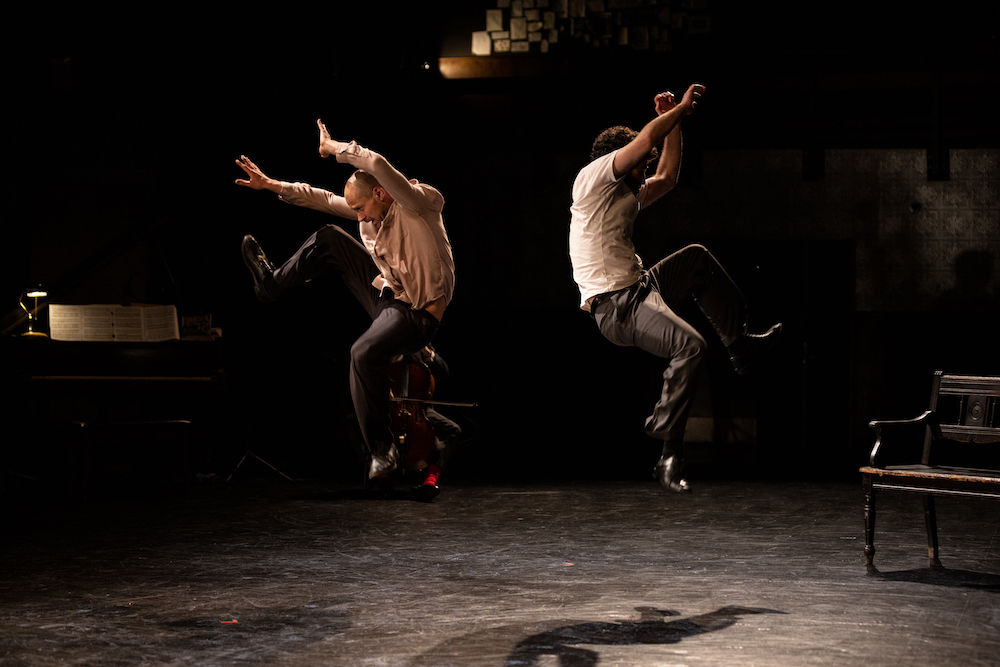
In a moment, Bobbi has been established as the director of this broken theater and we have been invited to glimpse behind the curtain. Before this realization can settle, Bobbi is promptly interrupted to audition for the role of Mother, which she throws herself into yielding hilarious and faintly disquieting effects. When the panel of evaluators situated far downstage asks her to bounce her imaginary baby in the harsh upstage spotlight, she does so in absurd ways. They test her reactions to classic mother-child altercations, ask her to fall with her baby, and even request she demonstrate her breastfeeding capacities. “Sing for your baby.”
The musicians pick up their instruments again and dancer Vinson Fraley contributes his astonishing vocals as the group, now dressed more formally, performs a unison phrase in a formation that spreads across the entirety of the stage. Bobbi stands downstage facing the back while the rest face front to a satisfying effect. The choreography is simple yet unpredictable in its varying rhythms, and the dancers remain distinctly human and individual even in their synchronicity. “It’s a ghost theater.”
Next, the back curtains open to the bustle of rehearsal. Two performers are running through a scene as the understudies do it behind them on mute in perfect unison. With each mishap, they pause and restart, making it through slightly more of the scene each time. The rehearsal director says the movement directions aloud between the performers’ spoken lines, occasionally announcing hilariously unachievable “changes of plan” in the moment. The “production manager” swoops in to demonstrate the fight scene while talking through its directions (a stage device that has been overused in recent years but is deeply warranted here), which include a self-indulgent shimmy just before the final victory –– it is both magnificently executed and hysterical. “This choreography is starting to look unfamiliar.”
When the curtain closes, the space is frantically reset and a trio ensues between the “main characters” from the scene before and the male understudy. The woman switches from partner to partner, repeating the choreography with each. The scene escalates until the woman performs the movement on her own, continuing past the violin music until she collapses into Bobbi’s arms. Toward the end of the piece, Bobbi introduces the cast: Jonathan is the dad/rehearsal director, Or is a brother and an ape, Judy is the jack of all trades, etc. But Jonathan doesn’t let her finish: “We have to move on.”
When Bobbi takes a knife to a sandbag hanging in the space, it makes a fog effect. Vinson sings, “One grain of sand” over and over, and the dancers leave one by one. “One drop of water in the sea. One little me.” Although the work doesn’t shy away from drama and literal moments, it is never cheesy or unconvincing, and each idea is explored for just the right amount of time. Broken Theater is astonishing for its ability to bring together an incredible diversity of movement vocabularies, ideas and emotions while building toward a collective statement that’s as clear as it is difficult to pinpoint.
La MaMa Moves! 2023 welcomed audiences out of COVID without hitting them over the head with post-pandemic rhetoric and content, and the diversity of artists and aesthetics uplifted did justice to the diversity of New York City and the international dance scene. Thanks to all at La MaMa for welcoming me into the organization’s various theater spaces and to the artists involved for pulling me into their distinctive worlds. Emerging from COVID, seeing so much dance –– so much life –– was a treat.
By Charly Santagado of Dance Informa.


